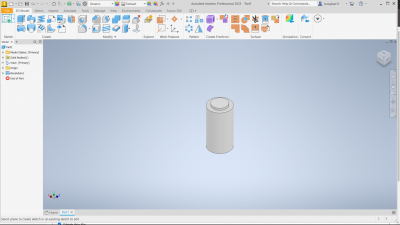M. Reyhan Fachriansyah Hermawan
Contents
Introduction
My conciousness is my top priority
Name: M. Reyhan Fachriansyah Hermawan
NPM: 2106657172
Major: Mechanical Engineering KKI
DoB: 19 April 2003
E-mail: reyhanfachriansyah@gmail.com
Hello All!
My name is Reyhan Fachriansyah, you can call me fahri. This is my page that contains the progress of my ongoing assigned project for Numerical Method course in my fourth semester. My future goal is to establish several high-tech manufacturing company revolving around robotics, sensors, and renewable energy. I hope by undertaking this course, i will bring my self closer to my goal by expanding my knowledge and conciousness
Class Abstract
23 May 2023
This day is the first day of our course, lectured by Pak Dr. Ahmad Indra Siswantara or commonly called as "pak Dai". In this day we were given knowledge about how conciousness highly important to our daily life espescially affecting Numerical Methodology. Pak Dai also lectured us about Cara Cerdas Ingat Tuhan.
30 May 2023
On today's session, Mr. Dai assigned us to discuss together about our main project of Numerical Method with our friend Patrick Samperuru as the discussion moderator as the head of class's replacement. Each of the attendants were given several chance of public-explanation in front of the class in order to complete our project, which entails designing a functional hydrogen tank that is optimized within the constraints of pressure constraints at 8 bar, 1 liter capacity, and a maximum budget of IDR 500,000, all participants are asked to contribute their thoughts in the form of opinions and personal viewpoints. There were two session on todays dicussion, which is material discussion and optimization discussion.
The discussion was then continued by one of our friend Patrick Samperuru in the first discussion for applicable materials, Patrick then listed a number of possible materials that can be used as the hydrogen tank based on the different hydrogen tank types such as type I, (all metal), type II, (metal with a carbon fiber wrap), type III, (composite with metal lining), and type IV, (composite with non-metal lining). But for this project, he reckon that the most probable type of hydrogen tank would be the type I or II since the production would be easier, and also theoritically be able to withold 8 bar of pressure, thus the end production price will be more affordable for our capped cost of IDR 500,000. In the next turn, Reyhan Fachri stated the details of several possible material that can be applied as hydrogen tank, this inlcudes AISI 316, AISI 304, AISI 316L, AISI 304L. Cu, or Al alloys are commonly used as the main material for hydrogen tanks since it is largely immune to hydrogen effects at ambient temperatures.
For the second session of the discussion which is optimization discussion several attendee points out the three key areas required for our optimization. The area consists of design variable, goal function, and constraint, all of which may vary for each member of the class. Reyhan Fachri began by describing his objective function, which is weight consideration. In sectors like aircraft, home appliences or the automobile, where weight is particularly important, hydrogen tanks are frequently employed. Therefore, while retaining structural integrity, the tank design should strive to reduce weight. Ikhsan Rahadian then points out the importance of structural integrity to bear internal pressure, external loads, and other environmental conditions, the tank has to be structurally sound. To assure the tank's stability and strength, structural study, including finite element analysis. After that, M. Annawfal Rizky mentioned that he wanted the limitation to be the compatibility with hydrogen gas: 'The tank material should be compatible with hydrogen gas to prevent any chemical reactions, embrittlement, or degradation that could affect the tank's performance or safety', he said.
Design and Optimization Project - Hydrogen Tank
Project Overview
This design and optimization project is assigned by our lecturer Pak Dr. Ahmad Indra Siswantara as an individual project/task as a learning method to use Numerical Method as a tool for real-life application problems. The project consist of designing a hydrogen tank with some constraints: consider being the gas pressurized at 8 bars, a required volume of 1 liter, and a maximum budget of 500,000 IDR to make one. Hydrogen gas has a high level of danger espescially when pressurized to a high pressure by reason of the likelihood of explosion. Thus, it is crucial for engineers to design and optimize a safe hydrogen tanks for several type of real life practices.
When building a hydrogen storage facility, the following factors should be taken into account:
- Fatigue Resistance: Tanks must be built to sustain the necessary pressure, which is commonly expressed in bars or pounds per square inch (psi). The needed material strength, wall thickness, and structural design will be determined by the pressure rating.
- Limitations on volume and shape: The tank's overall dimensions and shape will depend on the available space and required capacity. The tank should be made to fit the area allotted for it and to have the appropriate volume.
- Material compatibility: It's important to use materials that are friendly to hydrogen since it might embrittle or have other negative effects on some materials. Carbon fiber composites, high-strength steel alloys, and several aluminum alloys are popular options.
- Weight considerations: Applications where weight is important, such in the aerospace or automobile sectors that is frequently employ hydrogen tanks inside. Therefore, while retaining structural integrity, the tank design should be able to reduce it own weight.
- Safety Features: Due to its great flammability, hydrogen demands extra safety measures. To avoid overpressurization, reduce hazards, and maintain safe operation, it is crucial to include the proper safety measures, such as pressure release devices, burst discs, and leak detection systems.
- Operational Environtment: Which includes temperature changes, exposure to moisture or chemicals, and potential impacts or vibration. The tank should be constructed so that it can resist these circumstances without losing integrity.
Coding
import math
from scipy.optimize import minimize
def calculate_radius_height(x):
return x[0], 2 * x[0] # 2:1 ratio for height:radius
def calculate_thickness(radius, height):
return 0.1 # Fixed thickness of 0.1 cm
def calculate_capacity(radius, height):
volume = math.pi * radius**2 * height / 4 # Volume of a cylinder with 2:1 aspect ratio
capacity = volume * 1000 # Conversion from liter to cm^3
return capacity
def calculate_tensile_stress(radius, thickness):
tensile_strength = 75 * 1000 # ksi to psi conversion
return (tensile_strength * radius) / thickness
def objective_function(x):
radius, height = calculate_radius_height(x)
thickness = calculate_thickness(radius, height)
surface_area = 2 * math.pi * radius * (radius + height) # Surface area of the cylinder
return surface_area # Minimize surface area
def constraint(x):
radius, height = calculate_radius_height(x)
capacity = calculate_capacity(radius, height)
thickness = calculate_thickness(radius, height)
tensile_stress = calculate_tensile_stress(radius, thickness)
return [capacity - 1000, tensile_stress - 75000] # Constraints: 1 liter capacity, tensile stress <= 75 ksi
def optimize_hydrogen_tank():
# Initial guess for radius
x0 = [1] # [radius]
# Optimization bounds for radius
bounds = [(0, None)] # Radius must be non-negative
# Optimization
result = minimize(objective_function, x0, bounds=bounds, constraints={'type': 'ineq', 'fun': constraint})
# Extract optimized values
radius, height = calculate_radius_height(result.x)
thickness = calculate_thickness(radius, height)
# Print the optimized results
print("Optimal Radius: {:.2f} cm".format(radius))
print("Optimal Height: {:.2f} cm".format(height))
print("Optimal Thickness: {:.2f} cm".format(thickness))
print("Optimal Surface Area: {:.2f} cm^2".format(result.fun))
optimize_hydrogen_tank()
The code's output is displayed on the bottom left, along with the recommended shape for a cylindrical tank with a 1 liter volume with a constraint of 3mm of AISI 614 thickness is:
Optimal Radius: 0.86 cm Optimal Height: 1.72 cm Optimal Thickness: 0.10 cm (constraint) Optimal Surface Area: 13.95 cm^2
End Cap Compensation
Step 1: Convert the temperature from Celsius to Kelvin: T = 25°C + 273.15 T ≈ 298.15 K
Step 2: Calculate the volume of the cylindrical tank without the end caps: V_tank = πr²h V_tank ≈ π * (1.72 cm)² * 0.86 cm V_tank ≈ 3.14159 * 2.9584 cm² * 0.86 cmV_tank ≈ 14.34522 cm³
Step 3: Calculate the number of moles (n) of the gas using the ideal gas law: n = (P * V) / (R * T) n = (8 bar * 1000 cm³) / (0.0831 L·bar/(mol·K) * 298.15 K) n ≈ 322.28283 mol
Step 4: Calculate the volume of the end cap: V_end_cap = π * (1.72 cm)² V_end_cap ≈ 3.14159 * 2.9584 cm² V_end_cap ≈ 16.34602 cm³
Step 5: Subtract the volume of the end caps from the total volume of the tank: V_final = V_tank - (2 * V_end_cap) V_final = 14.34522 cm³ - (2 * 16.34602 cm³) V_final = 14.34522 cm³ - 32.69204 cm³ V_final = -18.34682 cm³
Since the result is negative (-18.34682 cm³), it indicates that the end cap compensation is larger than the original volume of the tank. In this case, it's not possible to have a cylindrical tank with a height of 0.86 cm, a radius of 1.72 cm, a volume of 1 liter, and a pressure of 8 bar for hydrogen gas while considering the end cap compensation.




